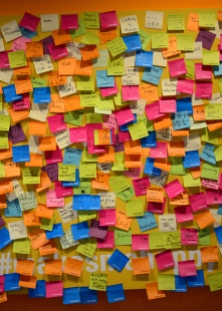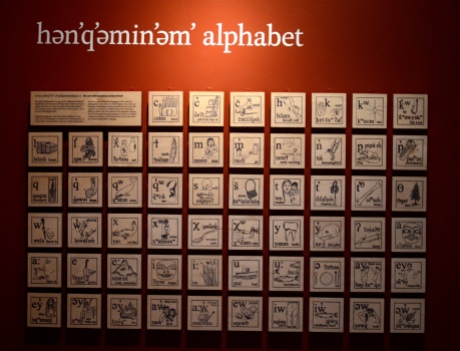Between the extravagant exterior and the highly official-sounding name, I imagined the Museum of Vancouver to be as extensive as The Museum of the City of New York or even The British Museum.
But the MOV turned out to be more humble than I expected. I wasn’t disappointed, per se, and in fact I quite enjoyed it, but I was surprised that it felt more personal than regal.
For starters, MOV is only made up of three exhibits. (Well, four, but one was closed when I went.)
The first is Stefan Sagmeister’s “The Happy Show.” Sagmeister combines infographics and interactive pieces that discuss sources of happiness from psychology to family to sexuality. All the installations include handwritten explanations or discussions, which makes it feel like reading class notes or a letter from a friend.
Visitors are asked to write sticky notes about what makes them happy and to rate their happiness 1-10. I loved seeing all the different ways people find joy in their lives, and I found it interesting that most people rated themselves as being very happy.
Some of his musings and ideas were deep and really made me think about my own emotions, and some were more light-hearted and humorous.
I’ve spent hours thinking about his proposition that people should take five years of their retirement and intersperse them into their working lives in order to contribute more to society. I also enjoyed his analysis of why we remember negative things more clearly than positive things and how that affects what we consider “news.” And I love how he turned an ordinary thermostat into one having an existential crisis.
After checking out the rest of the show (there’s A LOT that I haven’t mentioned), I went to the next exhibit: “c̓əsnaʔəm, the city before the city,” which focuses on the relationship between indigenous and settler societies in Vancouver. It discusses tools, geography, and language, and how all these things are important to preserve.
The language aspect, of course, appealed to me, because of my experiences with speech-language pathology. Their language has sounds that we’ve never heard and may not even be able to discern because of our lack of exposure.
I’ll be honest, I didn’t spend much time in this exhibit. I was exhausted and fading fast (I went to MOV the same day as my 5am photo shoot at Granville Island–by 11am I’d already been walking/lugging camera equipment for roughly 6 hours straight), and the dark room was putting me to sleep.
So I moved on to the next exhibit: a series of rooms showing what Vancouver was like in the 20th century. There were artifacts of everything from the the immigration boom and racial tensions with the incoming Chinese population to neon signs and replicas of 50s innovations.
At first, I was surprised at how similar the histories of the U.S. and Canada are, especially with Japanese internment and the Civil Rights movement. Then I was surprised that I was surprised. We’re taught U.S. history as if it’s completely unique, but social issues don’t exist in isolation. The fight for a better standard of living is universal.
After about two hours of sauntering through MOV, I was ready for a nap. But I’m really glad I went.
Not only did I discover some interesting history about both industrialized and indigenous Vancouver, I got to learn about myself. Definitely worth the price of admission.


















I love the happiness project – every time the magazine goes to shows, we ask people to write down their ‘simple things’ and it always makes for a fun afternoon reading the postcards in the office. Lots of people appreciate life and seem to have a good handle on what little stuff makes them happy.
LikeLike
Yes! Love this. I’m glad people have that sense.
LikeLike
I love installations like these, interactive and thoughtful. :)
LikeLike
Me too! I spent almost an hour in the first exhibit because I wanted to read and touch EVERYTHING.
LikeLike
That’s because I think many Americas are still stuck with the Exceptionalism mindset, particularly right-wingers and especially those who have never left US borders. In Europe, we have learnt to see Exceptionalism for what it is because we went through it through our own imperial periods.
I need to visit Vancouver but did visit Banff and Calgary when I visited in 2002. It looks such a lovely place!
You mention The British Museum. Have you been to the UK? I’ve seen your pictures in the past from continental Europe but hadn’t realised you had visited here too.
LikeLike
I visited England in 2008 or 2009 (I can’t remember), and I’ll be back in London this fall, but I’d love to do more of the UK. The rest of my family has been to Scotland but I opted for other things when they did that trip.
LikeLike
What a futuristic outside for a museum!
Those pictures you took of the happiness project are great, I never really thought of the amount of negative emotions we have…
LikeLike
Isn’t it cool? The whole exhibit blew my mind but obviously I couldn’t show all of it here. Truly inspiring.
LikeLiked by 1 person
Oh yes it is! I would have loved to see the whole exhibit, I don’t think that I will be going to Vancouver soon…
LikeLiked by 1 person
I’m with you, the native languages part would have fascinated me. The complexity and diversity of indigenous languages of the Americas (before contact) was fantastic. It’s a sad loss to us all that so many of these languages are extinct. I’m glad the museum is doing something to keep the information alive.
LikeLike
Me too! It’s amazing how many languages have died out completely or are on that path.
LikeLike
Very interesting exhibits! Very intrigued by the gumball visual.
LikeLike
Same! I wonder whether that distribution is the same as what they find in psychological studies.
LikeLike
What a unique museum! Very creative exhibits.
LikeLike
I thought so too, Erin!
LikeLike
The happiness project admittedly looks like the only exhibit I would be interested in, but it sounds like a meaningful one that would make a visit worth it. Part of it is also because it seems to reach out to be more personal and interact and make you think about the contents more than the other 2 exhibits.
LikeLike
True, the other two are more passive receiving of information but they’re interesting in their own ways. S
LikeLike
Thanks for visiting the Museum of Vancouver. So glad that you found happiness in our exhibitions, learned our city’s story, and found it worth recommending.
LikeLiked by 1 person
That happiness exhibit seems so neat. I’m impressed you did so much in one day! Good work!
LikeLike
I was EXHAUSTED. Thanks, Erin!
LikeLike
Neat! I’ve never been to Vancouver BC but I really want to go. Maybe in one of my years of interspersed retirement…. A girl can dream.
LikeLike
Hey, with an interspersed retirement, anything is possible.
LikeLike
Looks wonderful. BTW, I haven’t seen you around my blog lately…what’s up? What have you thought of my latest posts?
LikeLike
I love interactive museums, this one looks particularly interesting and a good chance for some self reflection!
http://www.racheltrieslife.com
LikeLike
Interactive museums are the BEST.
LikeLiked by 1 person
This sounds like a very different museum. All three segments sonds very interesting to me, and not really what you normally find in a museum… well, at least here in Europe ;-)
I’m familiar with a few American Indigenour languages… and they sure sound different. But I love hearing different languages, even if I don’t understand a single word.
LikeLike
It’s definitely a more modern museum than most of the ones in Europe :)
LikeLike
this looks pretty awesome! i need to get to vancouver more often!
LikeLike
For sure!
LikeLike
I just love museums so much. :D Love the creativity and interactivity here.
LikeLike
When I love a museum, it’s a pretty friggin’ awesome museum, since I have a relatively low tolerance for them.
LikeLiked by 1 person
Oh? Why low tolerance? (Career research. ;) )
LikeLike
I tend to not be interested in history or art that seem inaccessible. If it’s interactive I can get into it but row after row of artifact or painting is like…I can’t see the bigger picture?
LikeLike
Interesting. Museums are more traditionally repositories, and it’s more modern currents that want them to engage with the public. There seems to be some conflict about which museums should be doing what in that regard.
LikeLiked by 1 person
There’s a festival in Mumbai called Kala Ghoda (black horse) festival. Considering you have wanderlust I’m sure you wouldn’t mind coming. Its full of such pieces with description.
Alas people only take selfies and no one reads.
And as for the above, what was that ‘how happy are you?’ One
LikeLike
Ahhh that festival sounds amazing! The “how happy are you?” was part of the exhibit, where people take a gumball to represent how happy they are from a scale of 1-10, and everyone else can see how happy the other visitors are on average.
LikeLiked by 1 person
That’s a brilliant concept
LikeLiked by 1 person
Great post – I’ll have to visit next time I’m in Vancouver.
LikeLike
Thanks Ruth! Enjoy!
LikeLike
Me dull. You smart. That’s just what I needde.
LikeLike
Pingback: Why I Decided to Travel Full-Time After Graduation | Victim to Charm